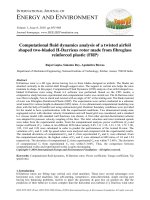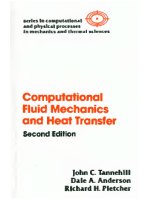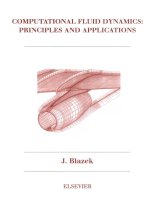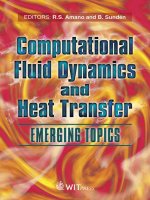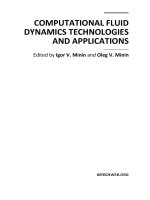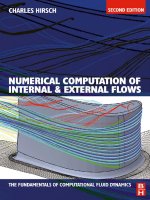computational fluid dynamics an heat transfer
Bạn đang xem bản rút gọn của tài liệu. Xem và tải ngay bản đầy đủ của tài liệu tại đây (8.95 MB, 506 trang )
CC
CC
C
omputational Fluid Dynamicsomputational Fluid Dynamics
omputational Fluid Dynamicsomputational Fluid Dynamics
omputational Fluid Dynamics
and Heat Tand Heat T
and Heat Tand Heat T
and Heat T
ransfransf
ransfransf
ransf
erer
erer
er
WIT
eLibrary
Home of the Transactions of the Wessex Institute, the WIT electronic-library
provides the international scientific community with immediate and permanent
access to individual papers presented at WIT conferences. Visit the WIT eLibrary
at
WIT Press publishes leading books in Science and Technology.
Visit our website for the current list of titles.
www.witpress.com
WIT
PRESS
International Series on Developments in Heat Transfer
Objectives
The Developments in Heat Transfer book Series publishes state-of-the-art books
and provides valuable contributions to the literature in the field of heat transfer,
thermal and energy engineering. The overall aim of the Series is to bring to the
attention of the international community recent advances in thermal sciences by
authors in academic research and the engineering industry.
Research and development in heat transfer is of significant importance to many
branches of technology, not least in energy technology. Developments include new,
efficient heat exchangers, novel heat transfer equipment as well as the introduction
of systems of heat exchangers in industrial processes. Application areas include heat
recovery in the chemical and process industries, and buildings and dwelling houses
where heat transfer plays a major role. Heat exchange combined with heat storage
is also a methodology for improving the energy efficiency in industry, while cooling
in gas turbine systems and combustion engines is another important area of heat
transfer research. Emerging technologies like fuel cells and batteries also involve
significant heat transfer issues.
To progress developments within the field both basic and applied research is
needed. Advances in numerical solution methods of partial differential equations,
turbulence modelling, high-speed, efficient and cheap computers, advanced
experimental methods using LDV (laser-doppler-velocimetry), PIV (particle-image-
velocimetry) and image processing of thermal pictures of liquid crystals, have all led
to dramatic advances during recent years in the solution and investigation of
complex problems within the field.
The aims of the Series are achieved by contributions to the volumes from invited
authors only. This is backed by an internationally recognised Editorial Board for the
Series who represent much of the active research worldwide. Volumes planned for
the series include the following topics: Compact Heat Exchangers, Engineering
Heat Transfer Phenomena, Fins and Fin Systems, Condensation, Materials Processing,
Gas Turbine Cooling, Electronics Cooling, Combustion-Related Heat Transfer,
Heat Transfer in Gas-Solid Flows, Thermal Radiation, the Boundary Element
Method in Heat Transfer, Phase Change Problems, Heat Transfer in Micro-Devices,
Plate-and-Frame Heat Exchangers, Turbulent Convective Heat Transfer in Ducts,
Enhancement of Heat Transfer, Transport Phenomena in Fires, Fuel Cells and
Batteries as well as Thermal Issues in Future Vehicles and other selected topics.
Series Editor
B. Sundén
Lund University
PO Box 118
SE-22100 Lund
Sweden
Associate Editors
R. Amano
University of Wisconsin, USA
C.A. Brebbia
Wessex Institute of Technology, UK
G. Comini
University of Udine, Italy
R.M. Cotta
COPPE/UFRJ, Brazil
S.K. Das
India Institute of Technology, Madras,
India
L. De Biase
University of Milan, Italy
G. De Mey
University of Ghent, Belgium
S. del Guidice
University of Udine, Italy
M. Faghri
University of Rhode Island, USA
C. Herman
John Hopkins University, USA
Y. Jaluria
Rutgers University, USA
S. Kabelac
Helmut Schmidt University, Hamburg,
Germany
D.B. Murray
Trinity College Dublin, Ireland
P.H. Oosthuizen
Queen’s University Kingston, Canada
P. Poskas
Lithuanian Energy Institute, Lithuania
B. Sarler
Nova Gorica Polytechnic, Slovenia
A.C.M. Sousa
University of New Brunswick, Canada
D.B. Spalding
CHAM, UK
J. Szmyd
University of Mining and Metallurgy,
Poland
D. Tafti
Viginia Tech., USA
Q. Wang
Xi’an Jiatong University, China
S. Yanniotis
Agricultural University of Athens, Greece
This page intentionally left blank
CC
CC
C
omputational Fluid Dynamicsomputational Fluid Dynamics
omputational Fluid Dynamicsomputational Fluid Dynamics
omputational Fluid Dynamics
and Heat Tand Heat T
and Heat Tand Heat T
and Heat T
ransfransf
ransfransf
ransf
erer
erer
er
EMERGING TOPICS
Editors
R.S. Amano
University of Wisconsin-Milwaukee, USA
&
B. Sundén
Lund University, Sweden
Published by
WIT Press
Ashurst Lodge, Ashurst, Southampton, SO40 7AA, UK
Tel: 44 (0) 238 029 3223; Fax: 44 (0) 238 029 2853
E-Mail:
For USA, Canada and Mexico
WIT Press
25 Bridge Street, Billerica, MA 01821, USA
Tel: 978 667 5841; Fax: 978 667 7582
E-Mail:
British Library Cataloguing-in-Publication Data
A Catalogue record for this book is available
from the British Library
ISBN: 978-1-84564-144-3
ISSN (print): 1369-7331
Library of Congress Catalog Card Number: 2010920129
The texts of the papers in this volume were set
individually by the authors or under their supervision.
No responsibility is assumed by the Publisher, the Editors and Authors for any injury
and/or damage to persons or property as a matter of products liability, negligence or
otherwise, or from any use or operation of any methods, products, instructions or
ideas contained in the material herein. The Publisher does not necessarily endorse
the ideas held, or views expressed by the Editors or Authors of the material contained
in its publications.
© WIT Press 2011
Printed in Great Britain by Quay Digital, Bristol.
All rights reserved. No part of this publication may be reproduced, stored in a retrieval
system, or transmitted in any form or by any means, electronic, mechanical,
photocopying, recording, or otherwise, without the prior written permission of the
Publisher.
R.S. Amano
University of Wisconsin-Milwaukee, USA
B. Sund
én
Lund University, Sweden
Contents
Preface xiii
I. Finite-Volume Method 1
1 A higher-order bounded discretization scheme 3
Baojun Song and R.S. Amano
1.1 Introduction …………………………………………………… 3
1.2 Numerical Formulation 6
1.2.1 Governing equations 6
1.2.2 Discretization 6
1.2.3 Higher-order schemes 7
1.2.4 Weighted-average coefficient ensuring
boundedness 8
1.3 Test Problem and Results 11
1.3.1 Pure convection of a box-shaped step profile 11
1.3.2 Sudden expansion of an oblique velocity field in a
cavity 12
1.3.3 Two-dimensional laminar flow over a fence 15
1.4 Conclusions 16
2
Higher-order numerical schemes for heat, mass, and
momentum transfer in fluid flow
19
Mohsen M.M. Abou-Ellail, Yuan Li and Timothy W. Tong
2.1 Introduction 20
2.2 Single-Grid Schemes 21
2.3 New Numerical Simulation Strategy 22
2.4 Novel Multigrid Numerical Procedure 23
2.5 The First Test Problem……………………………………… 29
2.6 Numerical Results of the First Test Problem 30
2.7 The Second Test Problem……………………………………. 39
2.8 Numerical Results of the Second Test Problem 41
2.9
Application of NIMO Scheme to Laminar Flow
Problems 44
2.9.1 Steady laminar flow in pipes 47
2.9.2 Steady laminar flow over a fence…………………… 48
2.10
Application of the NIMO Higher-Order Scheme to the
Turbulent Flow in Pipes 52
2.11 Conclusions 58
3 CFD for industrial turbomachinery designs 61
C. Xu and R.S. Amano
3.1 Introduction 61
3.1.1 Computational methods in turbomachinery 61
3.1.2 Grid-free vortex method 63
3.2 Numerical Methods for Incompressible Flow 64
3.3 Numerical Methods for Compressible Flow 65
3.4 Governing Equations for Two-Dimensional Flow 70
3.5 Decomposition of Flux Vector 72
3.5.1 Governing equations 72
3.5.2 Special treatment of the artificial dissipation terms
and numerical algorithm 74
3.6 Stability Analysis 77
3.7 Applications in Turbine Cascade 80
3.7.1 C3X turbine cascade 80
3.7.2 VKI turbine cascade 85
3.8 Numerical Method for Three-Dimensional Flows 88
3.9 Applications of Three-Dimensional Method 89
3.9.1 Analysis of pitch-width effects on the secondary-
flows of turbine blades 89
3.9.2 Flow around centrifuge compressors scroll tongue 101
3.10 CFD Applications in Turbomachine Design 113
3.10.1 Flow solver for section analysis 116
3.10.2 Optimization 116
II. Finite Element Method 127
4
The finite element method: discertization and
application to heat convection problems
129
Alessandro Mauro, Perumal Nithiarasu, Nicola Massarotti and
Fausto Arpino
4.1 Governing Equations 129
4.1.1 Non-dimensional form of fluid flow equations 129
4.1.2 Non-dimensional form of turbulent flow equations 138
4.1.3 Porous media flow: the generalized model equations.143
4.2 The Finite Element Method 146
4.2.1 Strong and weak forms 146
4.2.2 Weighted residual approximation 148
4.2.3 The Galerkin, finite element, method 149
4.2.4 Characteristic Galerkin scheme for
convection-diffusion equation 150
4.2.5 Stability conditions 155
4.2.6 Characteristic-based split scheme 157
5 Equal-order segregated finite-element method
for fluid flow and heat transfer simulation
171
Jianhui Xie
5.1 Introduction 171
5.2 Finite-Element Description 175
5.2.1 Two-dimensional elements 175
5.2.2 Three-dimensional elements 177
5.2.3 Degenerated elements 179
5.2.4 Special elements (rod and shell) 179
5.3
Governing Equations for Fluid Flow and Heat Transfer
Problems 179
5.3.1 General form of governing equations 180
5.3.2 Discretized equations and solution algorithm 182
5.3.3 Stabilized method 187
5.4 Formulation of Stabilized Equal-Order Segregated Scheme . 193
5.4.1 Introduction 193
5.4.2 FEM-based segregated formulation 195
5.4.3 Data storage and block I/O process 205
5.5 Case Studies 208
5.5.1 Two-dimensional air cooling box 208
5.5.2 CPU water cooling analysis 210
III.
Turbulent Flow Computations/Large Eddy
Simulation/Direct Numerical Simulation 215
6
Time-accurate techniques for turbulent heat transfer
analysis in complex geometries
21
7
Danesh K. Tafti
6.1 Introduction 217
6.2 General Form of Conservative Equations 218
6.2.1 Incompressible constant property assumption 220
6.2.2 Modeling turbulence 224
6.3
Transformed Equations in Generalized
Coordinate Systems 225
6.3.1 Source terms in rotating systems 226
6.4 Computational Framework 227
6.5 Time-Integration Algorithm 231
6.5.1 Predictor step 231
6.5.2 Pressure formulation and corrector step 232
6.5.3 Integral adjustments at nonmatching boundaries 239
6.6 Discretization of Convection Terms 240
6.7 Large-Eddy Simulations and Subgrid Modeling 246
6.8 Detached Eddy Simulations or Hybrid RANS-LES 252
6.9 Solution of Linear Systems 254
6.10 Parallelization Strategies 256
6.11 Applications 259
7
On large eddy simulation of turbulent flow and heat
transfer in ribbed ducts
265
Bengt Sundén and Rongguang Jia
7.1 Introduction 265
7.2 Numerical Method 267
7.3 Results And Discussion 267
7.3.1 Fully developed pipe flow 267
7.3.2 Transverse ribbed duct flow 269
7.3.3 V-shaped ribbed duct flow 271
7.4 Conclusions 273
8
Recent developments in DNS and modeling of turbulent
clows and heat transfer
275
Yasutaka Nagano and Hirofumi Hattori
8.1 Introduction 275
8.2 Present State of Direct Numerical Simulations 276
8.3 Instantaneous and Reynolds-Averaged Governing
Equations for Flow and Heat Transfer 277
8.4 Numerical Procedures of DNS 279
8.4.1 DNS using high-accuracy finite-difference method 280
8.4.2 DNS using spectral method 280
8.5 DNS of Turbulent heat Transfer in Channel Flow with
Transverse-Rib Roughness: Finite-Difference Method 281
8.5.1 Heat transfer and skin friction coefficients 281
8.5.2 Velocity and thermal fields around the rib 284
8.5.3 Statistical characteristics of velocity field and
turbulent structures 287
8.5.4 Statistical characteristics of thermal field and related
turbulent structures 291
8.6
DNS of Turbulent heat Transfer in Channel Flow with
Arbitrary Rotating Axes: Spectral Method 295
8.7
Nonlinear Eddy Diffusivity Model for Wall-Bounded
Turbulent Flow 301
8.7.1 Evaluations of existing turbulence models in
rotating wall-bounded flows 301
8.7.2 Proposal of nonlinear eddy diffusivity model for
wall-bounded flow 304
8.8 Nonlinear Eddy Diffusivity Model for Wall-Bounded
Turbulent Heat Transfer 310
8.8.1 Evaluations of turbulent heat transfer models in
rotating channel flows 310
8.8.2 Proposal of nonlinear eddy diffusivity model for
wall-bounded turbulent heat transfer 312
8.9 Model Performances 316
8.9.1 Prediction of rotating channel flow using NLEDMM 316
8.9.2 Prediction of rotating channel-flow heat transfer
using NLEDHM 322
8.10 Concluding Remarks 327
9
Analytical wall-functions of turbulence for complex
surface flow phenomena
331
K. Suga
9.1 Introduction 331
9.2 Numerical Implementation of Wall Functions 333
9.3 Standard Log-Law Wall-Function (LWF) 334
9.4 Analytical Wall-Function (AWF) 335
9.4.1 Basic strategy of the AWF 335
9.4.2 AWF in non-orthogonal grid systems 338
9.4.3 AWF for rough wall turbulent flow and heat
transfer 339
9.4.4 AWF for permeable walls 352
9.4.5 AWF for high Prandtl number flows 359
9.4.6 AWF for high Schmidt number flows 365
9.5 Conclusions 369
9.6 Nomenclature 376
IV. Advanced Simulation Modeling Technologies 381
10 SPH – a versatile multiphysics modeling tool 383
Fangming Jiang and Antonio C.M. Sousa
10.1 Introduction 383
10.2 SPH Theory, Formulation, and Benchmarking 384
10.2.1 SPH theory and formulation 384
10.2.2 Benchmarking 389
10.3 Control of the Onset of Turbulence in MHD Fluid Flow 392
10.3.1 MHD flow control 394
10.3.2 MHD modeling 395
10.3.3 SPH analysis of magnetic conditions to restrain the
transition to turbulence 396
10.4
SPH Numerical Modeling for Ballistic-Diffusive
Heat Conduction 400
10.4.1 Transient heat conduction across thin films 402
10.4.2 SPH modeling 403
10.4.3 Boundary treatment 405
10.4.4 Results 406
10.5
Mesoscopic Pore-Scale SPH Model for Fluid Flow
in Porous Media 409
10.5.1 Modeling strategy 412
10.5.2 Results and discussion 416
10.6 Concluding Remarks 420
11
Evaluation of continuous and discrete phase models
for simulating submicrometer aerosol transport and
deposition
425
Philip Worth Longest and Jinxiang Xi
11.1 Introduction 426
11.2 Models of Airflow and Submicrometer Particle Transport 428
11.2.1 Chemical species model for particle transport 428
11.2.2 Discrete phase model 429
11.2.3 Deposition factors 430
11.2.4 Numerical methods 430
11.3 Evaluation of Inertial Effects on Submicrometer Aerosols 431
11.4 An Effective Eulerian-Based Model for Simulating
Submicrometer Aerosols………………………………… 434
11.5
Evaluation of the DF-VC Model in an Idealized
Airway Geometry 437
11.6 Evaluation of the DF-VC Model in Realistic Airways 441
11.6.1 Tracheobronchial region 441
11.6.2 Nasal cavity 446
11.7 Discussion 451
12
Algorithm stabilization and acceleration in
computational fluid dynamics: exploiting recursive
properties of fixed point algorithms
459
Aleksandar Jemcov and Joseph P. Maruszewski
12.1 Introduction 460
12.2 Iterative Methods for Flow Equations 462
12.2.1 Discrete form of governing equations 463
12.2.2 Recursive property of iterative methods 465
12.3 Reduced Rank Extrapolation 467
12.4 Numerical Experiments 470
12.4.1 RRE acceleration of implicit density-based solver 470
12.4.2 RRE acceleration of explicit density-based solver 475
12.4.3 RRE acceleration of segregated pressure-based
solver 477
12.4.4 RRE acceleration of coupled pressure-based solver. 480
12.5 Conclusion 482
Sunden Prelims.tex 15/9/2010 15: 48 Page vii
Preface
The main focus of this book is to introduce computational methods for fluid flow
and heat transfer to scientists, engineers, educators, and graduate students who
are engaged in developing and/or using computer codes. The topic ranges from
basic methods such as a finite difference, finite volume, finite element, large-
eddy simulation (LES), and direct numerical simulation (DNS) to advanced, and
smoothed particle hydrodynamics (SPH). The objective is to present the current
state-of-the-art forsimulating fluid flowand heat transferphenomena inengineering
applications.
The first and second chapters present higher-order numerical schemes. These
schemes include second-order UPWIND, QUICK, weighted-average coefficient
ensuring boundedness (WACEB), and non-upwind interconnected multigrid over-
lapping (NIMO) finite-differencing and finite-volume methods. Chapter 3 gives
overview of the finite-difference and finite-volume methods covering subsonic to
supersonic flow computations, numerical stability analysis, eigenvalue-stiffness
problem, features of two- and three-dimensional computational schemes, and flux-
vector splitting technique. The chapter shows a few case studies for gas turbine
blade design and centrifugal compressor flow computations.
The fourth and fifth chapters give overview of the finite-element method
and its applications to heat and fluid flow problems. An introduction to
weighted residual approximation and finite-element method for heat and fluid
flow equations are presented along with the characteristic-based split algorithm
in Chapter 4. Chapter 5 discusses two important concepts. One is the equal-
order mixed-GLS (Galerkin Least Squares) stabilized formulation, which is a
generalization of SUPG (streamline-upwind/Petrov–Galerkin) and PSPG (pressure
stabilizing/Petrov–Galerkin) method.The second is the numerical strategies for the
solution of large systems of equations arising from the finite-element discretization
of the above formulations. To solve the nonlinear fluid flow/heat transfer problem,
particular emphasis is placed on segregated scheme (SIMPLE like in finite-volume
method) in nonlinear level and iterative methods in linear level.
Chapters6 through eightgivenumerical methods to solveturbulent flows. Chap-
ter 6 over views most important methods includingRANS approach, LES, andDNS
and describes the numerical and theoretical background comprehensively to enable
the use ofthese methods incomplex geometries. Chapter 7 demonstrates theadvan-
tages of large-eddy simulation (LES) for computations ofthe flow and heat transfer
in ribbed ducts through a gas turbine blade. Direct numerical simulation (DNS)
Sunden Prelims.tex 15/9/2010 15: 48 Page viii
is introduced in Chapter 8. In this chapter recent studies on DNS and turbulence
models from the standpoint of computational fluid dynamics (CFD) and compu-
tational heat transfer (CHT) are reviewed and the trends in recent DNS research
and its role in turbulence modeling are discussed in detail. Chapter 9 discusses
the analytical wall-function of turbulence for complex surface flows. This chap-
ter introduces the recently emerged analytical wall-function (AWF) methods for
surface boundary conditions of turbulent flows.
Some advanced simulation modeling technologies are given in chapters 10 and
11. In Chapter 10 the current state-of-the-art and recent advances of a novel numer-
ical method – the smoothed particle hydrodynamics (SPH) is reviewed through
case studies with particular emphasis on fluid flow and heat transport. To provide
sufficient background and to assess its engineering/scientific relevance, three par-
ticular case studies are used to exemplify macro- and nanoscale applications of
this methodology. The first application in this chapter deals with magnetohydrody-
namic (MHD) turbulence control. Chapter 11 provides the continuous and discrete
phasemodels forsimulatingsubmicrometer aerosoltransportand deposition. Lastly
Chapter 12 discusses convergence acceleration of nonlinear flow solvers through
use of techniques that exploit recursive properties fixed-point methods of CFD
algorithms.
The authors of the chapters were all invited to contribute to this book in accor-
dance with their expert knowledge and background. All of the chapters follow a
unifiedoutline and presentation to aidaccessibility and the bookprovidesinvaluable
information to researchers in computational studies.
Finally, we are grateful to the authors and reviewers for their excellent con-
tributions to complete this book. We are thankful for the ceaseless help that was
provided by the staff members of WIT Press, in particular Mr. Brian Privett and
Mrs. Elizabeth Cherry, and for their encouragement in the production of this book.
Finally, our appreciation goes to Dr. Carlos Brebbia who gave us strong support
and encouragement to complete this project.
Ryoichi S. Amano and Bengt Sunden
Sunden CH001.tex 17/8/2010 20: 14 Page 1
I. Finite-Volume Method
This page intentionally left blank
Sunden CH001.tex 17/8/2010 20: 14 Page 3
1 A higher-order bounded discretization
scheme
Baojun Song and Ryo S. Amano
University of Wisconsin–Milwaukee, Milwaukee, WI, USA
Abstract
This chapter presents an overview of the higher-order scheme and introduces a new
higher-order bounded scheme, weighted-average coefficient ensuring boundedness
(WACEB), for approximating the convective fluxes in solving transport equations
withthe finite-volumedifference method.Theweighted-average formulationis used
for interpolating the variables at cell faces, and the weighted-average coefficient is
determined from normalized variable formulation and total variation diminishing
(TVD) constraints to ensure the boundedness ofsolutions.The new scheme is tested
by solving three problems: (1) a pure convection of a box-shaped step profile in an
oblique velocity field, (2) a sudden expansion of anoblique velocity field in acavity,
and (3) a laminar flow over a fence. The results obtained by the present WACEB
are compared with the upwind and QUICK schemes and show that this scheme
has at least the second-order accuracy while ensuring boundedness of solutions.
Moreover, it is demonstrated that this scheme produces results that better agree
with the experimental data in comparison with other schemes.
Keywords: Finite-volume method, Higher-order scheme
1.1 Introduction
The approximation of the convection fluxes in thetransport equations has a decisive
influence on the overall accuracy of any numerical solution for fluid flow and heat
transfer. Although convection is represented by a simple first-order derivative, its
numerical representation remains one of the central issues in CFD.The classic first-
order schemes such as upwind, hybrid, and power-law are unconditionally bounded,
but tend to misrepresent the diffusion transport process through the addition of
numerical or “false” diffusion arising from flow-to-grid skewness. Higher-order
schemes, such as thesecond-order upwind [1] and thethird-order upwind (QUICK)
[2], offer a route to improve accuracy of the computations. However, they all
suffer from the boundedness problem; that is, the solutions may display unphysical
Sunden CH001.tex 17/8/2010 20: 14 Page 4
4 Computational Fluid Dynamics and Heat Transfer
oscillations in regions of steep gradients, which can be sufficiently serious to cause
numerical instability.
During the past two decades, efforts have been made to derive higher res-
olution and bounded schemes. In 1988, Zhu and Leschziner proposed a local
oscillation-damping algorithm (LODA) [3]. Since the LODA scheme introduces
the contribution of the upwind scheme, the second-order diffusion is introduced
into those regions where QUICK displays unbounded behavior. In 1988, Leonard
[4] developed a normalized variable formulation and presented a high-resolution
bounded scheme named SHARP (simple high-accuracy resolution program).
Gaskell and Lau [5] developed a scheme called SMART (sharp and monotonic algo-
rithm for realistic transport), which employs a curvature-compensated convective
transport approximation and a piecewise linear normalized variable formulation.
However, numerical testing [6] showsthat both SMART and SHARP need an under-
relaxation treatment at each of the control volume cell faces in order to suppress
the oscillatory convergence behavior. This drawback leads to an increase in the
computer storage requirement, especially for three-dimensional flow calculation.
In 1991, Zhu[7] proposed a hybrid linear/parabolic approximation (HLPA) scheme.
However, this method has only the second-order accuracy.
In the present study, a weighted-averaged formulation is employed to interpo-
late variables at cell faces and the weighted-average coefficient is determined based
on the normalized variable formulation and total variation diminishing (TVD) con-
straints. Three test cases are examined: a pure convection of a box-shaped step
profile in an oblique velocity field, a sudden expansion of an oblique velocity field
in a cavity, and laminar flow over a fence. Computations are performed on a gener-
alized curvilinear coordinate system. The schemes are implemented in a deferred
correction approach.The computed results are compared with those obtained using
QUICK and upwind schemes and available experimental data.
In CFD research, there are three major categories to be considered for flow
studies in turbines:
1. Mathematical models – the physical behaviors that are to be predicted totally
depend on mathematical models. The choice of mathematical models should
be carefully made, such as inviscid or viscous analysis, turbulence models,
inclusion of buoyancy, rotation, Coriolis effects, density variation, etc.
2. Numericalmodels – selection of a numerical technique is very important to judge
whether or not the models can be effectively and accurately solved. Factors that
need to be reviewed for computations include the order of accuracy, treatment
of artificial viscosity, consideration of boundedness of the scheme, etc.
3. Coordinate systems – the type and structure of the grid (structured or unstr uc-
tured grids) directly affect the robustness of the solution and accuracy.
Numerical studies demand, besides mathematical representations of the flow
motion, a general, flexible, efficient, accurate, and – perhaps most importantly –
stable and bounded (free from numerical instability) numerical algorithm for solv-
ing a complete set of average equations and turbulence equations. The formulation
Sunden CH001.tex 17/8/2010 20: 14 Page 5
A higher-order bounded discretization scheme 5
Table 1.1. Schemes used in CFD
Scheme Developers Order False Boundedness
diffusion
Upwind – 1st High Unconditionally
bounded
Hybrid Gosman (1977) 1st High Unconditionally
bounded
Power-law Patankar (1980) 1st Medium Unconditionally
bounded
Second-order Price et al. (1966) 2nd Low Unbounded
upwind
QUICK Leonard (1979) 3rd Low Unbounded
LODA Zhu–Leschziner 2nd Low Conditionally
(1988) bounded
SHARP Leonard (1988) 2nd Low Conditionally
bounded
SMART Gaskell–Lau (1988) 2nd Low Conditionally
bounded
WACEB Song et al. (1999) 2nd Low Unconditionally
bounded
of the discretization scheme of convection fluxes may be one of the major tasks to
meet such demands.
As for the numerical method, the classic first-order schemes such as upwind,
hybrid, and power-law [8] are unconditionally bounded (solutions do not suffer
from over/undershoot), but tend to misrepresent the transport process through
addition of numerical diffusion arising from flow-to-grid skewness. These are the
schemes that most of the commercial codes employ. In some applications, small
overshoots and undershoots may be tolerable. However, under other circumstances,
the nonlinear processes of turbulence diffusion will feed back and amplify these
over/undershoots, and may lead to divergence of a solution. During the past decade,
efforts have been made to derive high-resolution and bounded schemes. LODA,
SHARP, and SMART all display unbounded behavior, which leads to an increase
in the computer storage requirement, especially for three-dimensional flow cal-
culations. Therefore, the traditional method for simulating turbulent flows is the
hybrid (upwind/centraldifferencing) scheme, and the upwind is used for turbulence
equations such as kinetic energy equation, dissipation rate equation, and Reynolds
stress equations. Since it has a poor track record, one should always be suspicious
of the first-order upwind scheme.
Sunden CH001.tex 17/8/2010 20: 14 Page 6
6 Computational Fluid Dynamics and Heat Transfer
1.2 Numerical Formulation
1.2.1 Governing equations
The conservation equations governing incompressible steady flow problems are
expressed in the following general form:
div[ρ
V −
grad()] = S
(1)
where is any transport variable,
V the velocity vector, ρ the density of the fluid,
the diffusive coefficient, and S
is the source term of variable .
With ξ, η, and ζ representing the general curvilinear coordinates in three-
dimensional framework, the transport equation (1) can be expressed as:
1
J
∂ρU
∂ξ
+
∂ρV
∂η
+
∂ρW
∂ζ
=
1
J
∂
∂ξ
J
(q
11
ξ
)
+
1
J
∂
∂η
J
(q
22
η
)
+
1
J
∂
∂ζ
J
(q
33
ζ
)
+ S
CD
+ S
(ξ, η, ζ)
(2)
where U, V, and W are contravariant velocities defined as follows:
U = j
11
u +j
21
v +j
31
w (3a)
V = j
12
u +j
22
v +j
32
w (3b)
W = j
13
u +j
23
v +j
33
w (3c)
J is the Jacobiancoefficient, q
ij
and j
ij
(i =1−3 and j =1 −3) are the transforma-
tion coefficients (refer to the appendix), and S
CD
is the cross-diffusion term (refer
to the appendix).
1.2.2 Discretization
The computational domain is uniformly divided into hexahedral control volumes,
and the discretization of transport equation (2) is performed in the computational
domain following the finite-volume method.
Integrating equation (2) over a control volume as shown in Figure 1.1 and
applying the Gauss DivergenceTheorem in conjunction with central difference for
diffusion, we have:
F
e
− F
w
+ F
n
− F
s
+ F
t
− F
b
= S
V +S
CD
V (4)
where F
f
represents the total fluxes of across the cell face f (f =e, w, b, s, b, t).
Sunden CH001.tex 17/8/2010 20: 14 Page 7
A higher-order bounded discretization scheme 7
W
z T
w
t
s
S
b
b
P
e
x E
n
Figure 1.1. A typical control volume.
Taking the east face as an example, the total fluxes across it can be written as:
F
e
= (ρU)
e
−
J
J
11
e
(
E
−
P
) (5)
In the above equation, the cell face values of can be approximated with different
schemes.
For the first-order upwind scheme, the cell face value is expressed as:
e
=
P
if U
e
> 0
e
=
E
if U
e
< 0
(6)
Substituting equations (5) and (6) into equation (4), we have:
A
P
P
=
i=E,W,N,S,T,B
A
i
i
+ S
C
(7)
wheresubscript i denotes neighboring grid points, A
P
and A
i
the coefficients relating
to the convection and diffusion, and S
c
is the source term.
1.2.3 Higher-order schemes
The approximation ofconvection has a decisive influence on the overall accuracy of
the numerical simulations for a fluid flow. The first-order schemes such as upwind,
hybrid, and power-law all introduce the second-order derivatives that then lead
to falsely diffusive simulated results. Therefore, the higher-order schemes have
Sunden CH001.tex 17/8/2010 20: 14 Page 8
8 Computational Fluid Dynamics and Heat Transfer
to be used to increase the accuracy of the solution. Generally, with uniform grid
spacing, the higher-order interpolation schemes can be written in the following
weighted-average form:
e
=
P
+
1
4
[(1 −κ)
−
e
+ (1 +κ)
e
]ifU
e
> 0
e
=
E
−
1
4
[(1 −κ)
+
e
+ (1 +κ)
e
]ifU
e
< 0 (8)
where
−
e
=
P
−
W
,
e
=
E
−
P
,
+
e
=
EE
−
E
and κ is the weighted-
average coefficient. In equation (8), the underlined terms represent the fragments
of the first-order upwind scheme. Therefore, the higher-order schemes can be
implemented in a deferred correction approach proposed by Khosla and Rubin
[9]; that is,
n+1
f
=
UP,n+1
f
+ (
HO,n
f
−
UP,n
f
) (9)
where n indicates the iteration level, and UP and HO refer to the upwind and
higher-order schemes, respectively. The convective fluxes calculated by the upwind
schemes are combined with the diffusion term to form the main coefficients of the
difference equation, while those resulting from the deferred correction terms are
collected into the source term, say, S
DC
. Such a treatment leads to a diagonally
dominant coefficient matrix and enables a higher-order accuracy to be achieved at
a converged stage.
With this method, the deferred correction source term, taking east–west
direction as an example, is calculated by:
S
DC
=
1
4
U
+
e
U
e
[(1 +κ)
e
+ (1 −κ)
−
e
] −U
−
e
U
e
[(1 +κ)
e
+ (1 −κ)
+
e
]
− U
+
w
U
w
[(1 +κ)
w
+ (1 −κ)
−
w
] +U
−
w
U
w
[(1 +κ)
w
+ (1 −κ)
+
w
]
(10)
where U
±
e
is defined as:
U
±
f
=
1 ±sgn(U
f
)
2
If κ is fixed at a suitable constant value everywhere, several well-known schemes
can be formed.
However, the schemes listed inTable1 all sufferfromboundedness problem; that
is, the solutions may display unphysical oscillations in regions of steep gradients,
which can be sufficiently serious to lead to numerical instability.
1.2.4 Weighted-average coefficient ensuring boundedness
Based on the variable normalization proposed by Leonard [4], with a three-node
stencil as shown in Figure 1.2, we introduce a normalized variable defined as:
˜
=
−
U
D
−
U
(11)
Sunden CH001.tex 17/8/2010 20: 14 Page 9
A higher-order bounded discretization scheme 9
Table 1.2. Typical interpolation schemes
Expression for
e
when u > 0 Leading truncation error term
1/2(3
P
−
W
) 3/8x
3
1/2(
E
+
P
) 1/8x
2
1/8(3
E
+6
P
−
W
) 1/16x
3
1/6(2
E
+5
P
−
W
) −1/24x
2
F
U
WEPwe
F
C
F
f
F
D
Figure 1.2. Three-node stencil.
where the subscripts U and D represent the upstream and downstream loca-
tions, respectively. In the normalized form, the higher-order schemes can be
rewritten as:
˜
f
=
˜
C
+
1
4
[(1 +κ)(1 −
˜
C
) +(1 −κ)
˜
C
] (12)
See Figure 1.2 for notations of the terms. Solving for κ,
κ =
4
˜
f
− 4
˜
C
− 1
1 −2
˜
C
(13)
In order to ensure boundedness, the TVD constraints can be used; that is,
˜
f
≤ 1,
˜
f
≤ 2
C
,
˜
f
≥
˜
C
for 0 <
˜
C
< 1
˜
f
=
˜
C
for
˜
C
≤ 0or
˜
C
≥ 1 (14)
which correspond to the triangle region shown in Figure 1.3.
Sunden CH001.tex 17/8/2010 20: 14 Page 10
10 Computational Fluid Dynamics and Heat Transfer
TVD
constraints
A
1.0
B 1.0
CF
c
WACEB
QUICK
~
2F
c
~
F
f
~
F
c
~
Figure 1.3. Diagrammatic representation of the TVD constraint and WACEB
scheme.
The Taylor series expansion shows that the first two leading trunca-
tion error terms of the interpolation scheme (7) are 1/4(κ −1/2)x
2
and
1/8(1 −κ)x
3
. Therefore, the scheme has at least the second-order accuracy.
The maximum accuracy (third order) can be achieved if κ is set equal to 1/2. Thus,
the scheme can be formed in such a way that κ lies as close as possible to 1/2, while
satisfying the TVD constraints. Based on this idea, the normalized cell face value
can be computed by the following expressions:
˜
f
=
⎧
⎪
⎪
⎪
⎪
⎨
⎪
⎪
⎪
⎪
⎩
˜
C
˜
C
/∈ [0, 1]
2
˜
C
˜
C
∈ [0, 0.3)
3/8(2
˜
C
+ 1)
˜
C
∈ [0.3, 5/6]
1
˜
C
∈ (5/6, 1]
(15)
As shown in Figure 1.3, TVD constraints are overly restrictive according to
convection boundedness criterion (CBC). However, the use of a larger multiplying
constant will not noticeably increase the accuracy. The reasons are that, first, the
constant affects the accuracy only in the range from A to B (see Figure 1.3), and
this range varies at most from 0 to 0.3 (if we use constant 3, A=0.1666 and
B =0.3). Secondly, even with the smaller constant, the accuracy of the scheme is
still second order. Therefore, the present WACEB (weighted-average coefficient
ensuring boundedness) scheme employs normalized variable formulation (15) to
calculate the weighted-average coefficient to preserve boundedness.


